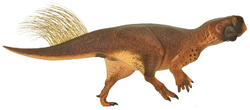History
During an 1873 trip through the western US, paleontologist and naturalist Edward Drinker Cope collected some fragmentary dinosaurian material which he soon named as a new genus. [1] Catalogued today as AMNH FR 3950, [2] the type material included three dorsal vertebrae, limb bone material, and what are now known to be horn cores, from a subadult individual. [3] Although it was briefly mixed up with hadrosaurs, and even considered to be a possible synonym of Trachodon , [4] it was recognized as a horned dinosaur in time for the first monograph on horned dinosaurs (1907), wherein it was regarded as based on indeterminate material. [5] Today, the name is used as little more than a historical curiosity, as it dates from a time before horned dinosaurs were known to exist. [6] The most recent review listed it as an indeterminate ceratopsid. [7]
It has sometimes been listed as a synonym of Agathaumas , [8] or Triceratops . [9]
This page is based on this
Wikipedia article Text is available under the
CC BY-SA 4.0 license; additional terms may apply.
Images, videos and audio are available under their respective licenses.



